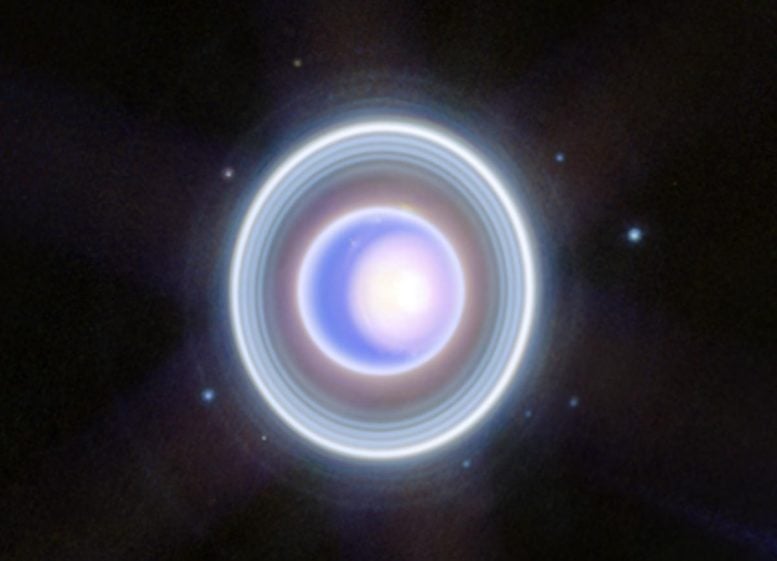
The James Webb Space Telescope has captured detailed images of Uranus, revealing its dynamic atmosphere, including rings, moons, and storms. This enhanced view contrasts with earlier images, showing a more active Uranus with a prominent seasonal north polar cloud cap and several storms. These observations are vital for understanding the planet’s complex atmosphere and may also provide insights into the study of exoplanets. Credit: NASA, ESA, CSA, STScI
New View Reveals a Strange and Dynamic Ice World
When Voyager 2 flew past Uranus in 1986, the planet appeared to be a nearly featureless, solid blue ball. Now, Webb shows us an infrared view that is much more dynamic and intriguing. Rings, moons, storms, and a bright, north polar cap grace these new images. Because Uranus is tipped on its side, the polar cap appears to become more prominent as the planet’s pole points towards the Sun and receives more sunlight — a time called solstice. Uranus reaches its next solstice in 2028, and astronomers will watch for changes in the planet’s atmosphere. Studying this ice giant can help astronomers understand the formation and meteorology of similarly sized planets around other suns.
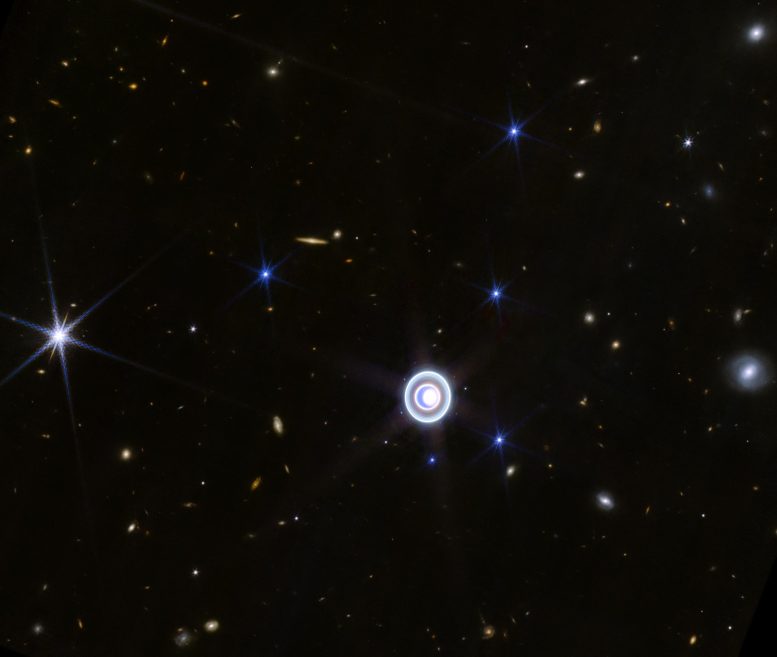
This image of Uranus from NIRCam (Near-Infrared Camera) on NASA’s James Webb Space Telescope shows the planet and its rings in new clarity. The planet’s seasonal north polar cap gleams in a bright white, and Webb’s exquisite sensitivity resolves Uranus’ dim inner and outer rings, including the Zeta ring—the extremely faint and diffuse ring closest to the planet.
This Webb image also shows 14 of the planet’s 27 moons: Oberon, Titania, Umbriel, Juliet, Perdita, Rosalind, Puck, Belinda, Desdemona, Cressida, Ariel, Miranda, Bianca, and Portia.
Credit: NASA, ESA, CSA, STScI
Webb Space Telescope Rings in the Holidays With the Ringed Planet Uranus
NASA’s James Webb Space Telescope recently trained its sights on unusual and enigmatic Uranus, an ice giant that spins on its side. Webb captured this dynamic world with rings, moons, storms, and other atmospheric features – including a seasonal polar cap. The image expands upon a two-color version released earlier this year, adding additional wavelength coverage for a more detailed look.
Uranus’ Rings and Moons in New Light
With its exquisite sensitivity, Webb captured Uranus’ dim inner and outer rings, including the elusive Zeta ring – the extremely faint and diffuse ring closest to the planet. It also imaged many of the planet’s 27 known moons, even seeing some small moons within the rings.
In visible wavelengths as seen by Voyager 2 in the 1980s, Uranus appeared as a placid, solid blue ball. In infrared wavelengths, Webb is revealing a strange and dynamic ice world filled with exciting atmospheric features.
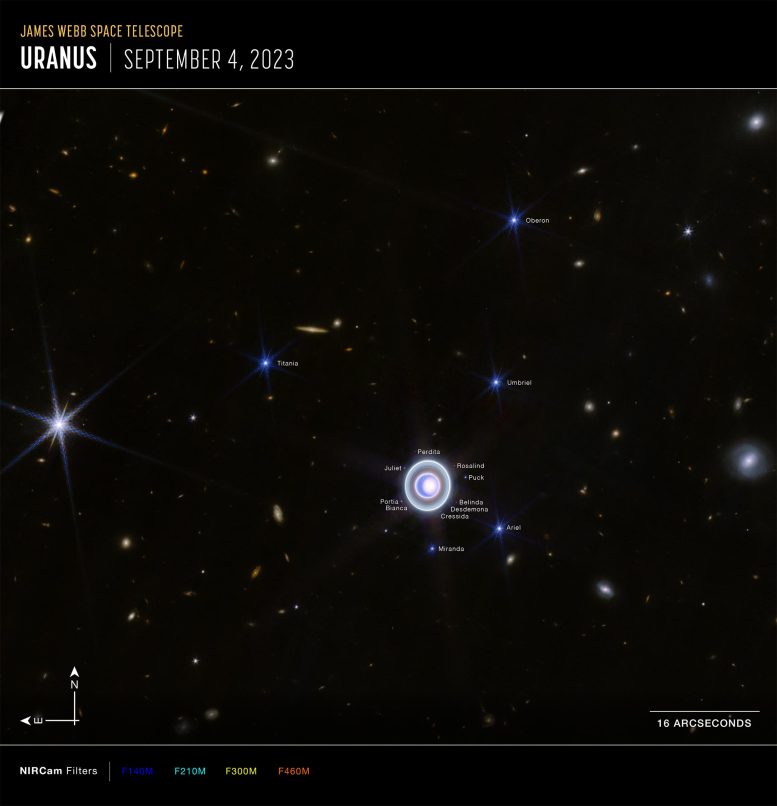
This image of Uranus, captured by Webb’s Near-Infrared Camera (NIRCam), shows compass arrows, scale bar, and color key for reference.
The north and east compass arrows show the orientation of the image on the sky. Note that the relationship between north and east on the sky (as seen from below) is flipped relative to direction arrows on a map of the ground (as seen from above).
The scale bar is labeled 16 arcseconds. The length of the scale bar is approximately one-seventh the total width of the image
This image shows invisible near-infrared wavelengths of light that have been translated into visible-light colors. The color key shows which NIRCam filters were used when collecting the light. The color of each filter name is the visible light color used to represent the infrared light that passes through that filter.
Credit: NASA, ESA, CSA, STScI
Atmospheric Phenomena and Seasonal Changes
One of the most striking of these is the planet’s seasonal north polar cloud cap. Compared to the Webb image from earlier this year, some details of the cap are easier to see in these newer images. These include the bright, white, inner cap and the dark lane in the bottom of the polar cap, toward the lower latitudes.
Several bright storms can also be seen near and below the southern border of the polar cap. The number of these storms, and how frequently and where they appear in Uranus’s atmosphere, might be due to a combination of seasonal and meteorological effects.
The polar cap appears to become more prominent when the planet’s pole begins to point toward the Sun, as it approaches solstice and receives more sunlight. Uranus reaches its next solstice in 2028, and astronomers are eager to watch any possible changes in the structure of these features. Webb will help disentangle the seasonal and meteorological effects that influence Uranus’s storms, which is critical to help astronomers understand the planet’s complex atmosphere.
Uranus’ Unique Tilt and Future Research
Because Uranus spins on its side at a tilt of about 98 degrees, it has the most extreme seasons in the solar system. For nearly a quarter of each Uranian year, the Sun shines over one pole, plunging the other half of the planet into a dark, 21-year-long winter.
With Webb’s unparalleled infrared resolution and sensitivity, astronomers now see Uranus and its unique features with groundbreaking new clarity. These details, especially of the close-in Zeta ring, will be invaluable to planning any future missions to Uranus.
Uranus: A Proxy for Exoplanet Studies
Uranus can also serve as a proxy for studying the nearly 2,000 similarly sized exoplanets that have been discovered in the last few decades. This “exoplanet in our backyard” can help astronomers understand how planets of this size work, what their meteorology is like, and how they formed. This can in turn help us understand our own solar system as a whole by placing it in a larger context.
The James Webb Space Telescope is the world’s premier space science observatory. Webb is solving mysteries in our solar system, looking beyond to distant worlds around other stars, and probing the mysterious structures and origins of our universe and our place in it. Webb is an international program led by NASA with its partners, ESA (European Space Agency) and the Canadian Space Agency.

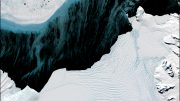
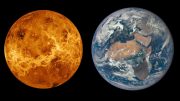



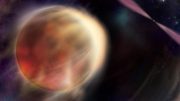


Sorry, that was just last night’s curry dinner.
Welp Honey, guess I’d better call the Emissions Police now!